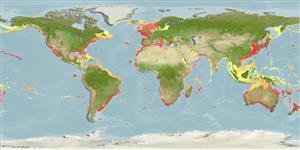Common names from other countries
>
Syngnathiformes (Pipefishes and seahorses) >
Centriscidae (Snipefishes and shrimpfishes) > Macroramphosinae
Etymology: Macroramphosus: Greek, makros = great + Greek, rhamphos = beak, bill (Ref. 45335).
More on author: Linnaeus.
Environment: milieu / climate zone / depth range / distribution range
экология
морской демерсальный; пределы глубины 25 - 600 m (Ref. 9563), usually 50 - 350 m (Ref. 47377). Subtropical; 66°N - 43°S, 180°W - 180°E
Western Atlantic: Gulf of Maine to Argentina (Ref. 37039). Eastern Atlantic and Mediterranean. Indo-West Pacific. Mainly in temperate latitudes between 20° and 40°N. Presence in Somalia to be confirmed (Ref. 30573).
Size / Вес / Возраст
Maturity: Lm ? range ? - ? cm
Max length : 20.0 cm TL самец/пол неопределен; (Ref. 4508); common length : 12.0 cm TL самец/пол неопределен; (Ref. 4508)
Краткое описание
определительные ключи | морфология | морфометрия
колючие лучи спинного плавника (общее число) : 6 - 8; членистые (мягкие) лучи спинного плавника (общее число) : 11 - 13; колючие лучи анального плавника: 0; членистые (мягкие) лучи анального плавника: 18 - 20; позвонки: 24. Reddish pink in color, silvery below (Ref. 5382). Body compressed, without scales. Mouth is placed at the end of the long tubular snout (Ref. 35388). Snout length (6.1cm), length of second dorsal spine (LDS 3.9 cm) (Ref. 39875).
Found between the seabed and midwater on the lower continental shelf, over sand. Juveniles found in oceanic surface waters (Ref. 2683); adults normally live close to the bottom (normally in 50-350 m depth (Ref. 47377)). Gregarious. Juveniles feed mainly on pelagic invertebrates, mainly copepods, while adults feed on bottom invertebrates (Ref. 6732). Seems to be sympatric with Macroramphosus gracilis (Lowe, 1839) all around the world (Ref. 89357).
Life cycle and mating behavior
Maturities | размножение | Spawnings | Egg(s) | Fecundities | личинки
Ehrich, S., 1990. Macroramphosidae. p. 656-657. In J.C. Quero, J.C. Hureau, C. Karrer, A. Post and L. Saldanha (eds.) Check-list of the fishes of the eastern tropical Atlantic (CLOFETA). JNICT, Lisbon; SEI, Paris; and UNESCO, Paris. Vol. 2. (Ref. 4508)
Статус Красного Списка МСОП (Ref. 130435)
CITES (Ref. 128078)
Not Evaluated
Угроза для людей
Harmless
Использование человеком
рыболовство: коммерческий; аквариум: общественные аквариумы
дополнительная информация
инструменты
Специальные отчеты
Скачать в формате XML
ресурсы в Интернет
Estimates based on models
Preferred temperature (Ref.
115969): 6.5 - 22.7, mean 13.6 (based on 2092 cells).
Phylogenetic diversity index (Ref.
82804): PD
50 = 0.7502 [Uniqueness, from 0.5 = low to 2.0 = high].
Bayesian length-weight: a=0.00891 (0.00668 - 0.01189), b=2.83 (2.75 - 2.91), in cm Total Length, based on LWR estimates for this species (Ref.
93245).
Trophic level (Ref.
69278): 3.5 ±0.40 se; based on food items.
устойчивость к внешним воздействиям (Ref.
120179): средний (среднего размера), минимальное время удвоения популяции 1.4-4.4 года (K=0.36-0.46; tmax=6).
Fishing Vulnerability (Ref.
59153): Low to moderate vulnerability (27 of 100).
